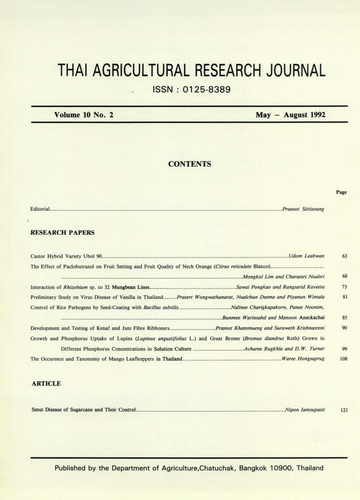Interaction of Rhizobium sp. to 32 Mungbean Lines
Keywords:
rhizobium inoculum, inefficient an defficient nodules, natural population of rhizobi, standard cultivarAbstract
The 32 selected mungbean lines (Vigna radiata) derived from the Mungbean Breeding Project and the standard cultivar, Uthong-1, were grown for study of the response to rhizobium in two inoculated conditions: inoculation and no-inoculation at Kasetsart University, Kamphaeng Saen Campus. The non-resplicated design was employed due to the inadequacy of seeds. Mixed 15-15-15 fertilizer was applied at the rate of 25 kg/rai. seedlings were thinned to 10 plants per linear metre giving a target population of 32,000 plants/rai. At full bloom or the beginning of young pod formation, 10 plants at random from the two middle rows were fug for observation on nodule formation on the tap and lateral roots. Large size nodules (not less than 0.1 cm in diameter) whether formed on the tap or lateral roots were recorded. Then, 10 randomed nodules from each type of roots were cut to identify whether as inefficient or efficient nodules. Effectient nodules had pink-red interior. Some other characteristics, yield and yield components were also recorded.
The results showed that in average nodules on brance roots were about 3 to 4 folds more than on tap root of the same plant in almost every lines tested. every lines responded differently to the nodule formation, inoculated treatment was superior to the no inoculation either no quantity and efficiency. The pressence of nodules on the no inoculation treatment indicated that natural population of rhizobia or population of rhizobia from previous crops were present in the soil.
Lines thant were well nodulated and produced efficient nodules with relatively high yield whether inoculated or not inoculated were as follows: VC 2742-36-3B, VC 2742-38-3B, VC 2754-9-3B and VC 2745-20-3B.
Downloads
Published
How to Cite
Issue
Section
License

This work is licensed under a Creative Commons Attribution-NonCommercial-NoDerivatives 4.0 International License.
Thai Agricultural Research Journal


